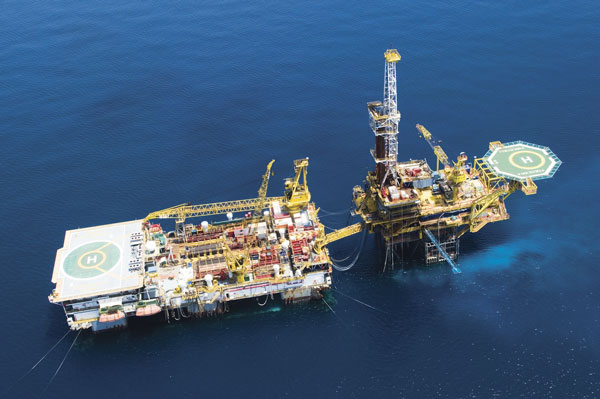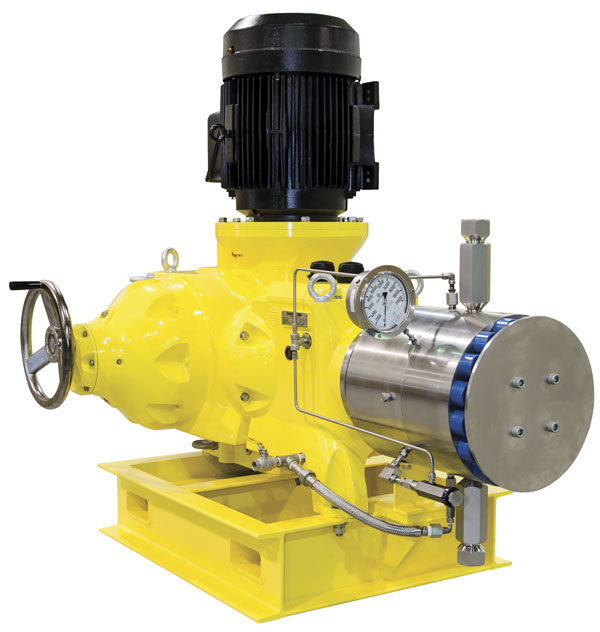As major independent and national oil companies in the Middle East and North Africa face the possibility of fewer projects and tighter budgets, producers can enhance efficiency by modernizing aging equipment. Metering pump technology plays an important role in operational efficiency and saves costs by increasing safety, improving production and maximizing well life.
In Egypt, energy demands have more than doubled during the last decade. With a growing economy and a rising standard of living, consumption is rising faster than production. Egypt has traditionally relied on a combination of natural gas and crude oil to meet domestic demand. While oil production has remained steady, gas production has increased. The market for unconventional shale and sandstone products is expected to be a significant growth area in the region.
 In offshore oil and gas operations, metering pumps must have enough power to handle high pressures. (Images courtesy of Milton Roy)
In offshore oil and gas operations, metering pumps must have enough power to handle high pressures. (Images courtesy of Milton Roy)In a recent operation, one of Egypt's largest oil and gas producers needed to replace almost 200 metering pumps because of repeated operational problems. More reliable pumps were needed that could function in a wide variety of environments. In harsh desert conditions, temperatures can vary from 50 degrees Celsius in the summer to 0 C in winter. In offshore environments, more power from equipment is required to operate at greater depths with extreme pressure.
Increased Well Life
Metering pumps keep oil and gas flowing by injecting chemicals such as methanol, monoethylene glycol and corrosion inhibitors into main lines to prevent hydrate formation, wax and scale deposits, and corrosion. These deposits hinder flow and lower product recovery rates. If the flow of these chemicals stops, production can come to a halt. Corrosion inhibitors also add a higher level of safety to operations, by helping to prevent leaks and spills at the wellhead, and in pipelines that carry the oil and derivative petroleum products from upstream wellheads to downstream refineries.
For more than 20 years, this Egyptian operator had been extracting oil and gas consistently. Locally built chemical injection skids with high-pressure pumps injected corrosion inhibitors into wellheads to protect pipelines and increase pipe life. Methanol, glycol, demulsifiers and scale inhibitors prevented problems in production and the refining process.
The operator's metering pumps had been constructed with a low-grade stainless steel. They required replacement parts and arduous maintenance that slowed operations. In addition to production delays, the pumps failed to deliver the chemicals as needed, risking clogs in the well.
The Egyptian operator recognized the value in upgrading their metering pump technology. As a result, the new pumps are able to withstand the harsh environmental conditions and meet performance requirements while reducing the maintenance of existing pumps.
Equipment Upgrades
All metering pumps should use durable materials and benefit from state-of-the-art design processes, delivering the right pump for the application.
1. Liquid End
The most important part of a metering pump is the liquid end—the section of the pump that comes in contact with the acids, bases, corrosive liquids and slurries. Metering pumps must provide chemical resistance to the solvents and harsh materials that are pumped through them. The pump's motor drives a piston to create a vacuum through which chemicals enter the liquid end. Alternating piston strokes create pressure that closes the inlet value, opens the outlet valve, forces the liquids into an umbilical and then delivers them to the wellhead. The operator determines the precise dosage rates and implements them through a distributed control system.
 The most important part of a metering pump is the liquid end—the section of the pump that comes in contact with the acids, bases, corrosive liquids and slurries. Metering pumps must provide chemical resistance to the solvents and harsh materials that are pumped through them.
The most important part of a metering pump is the liquid end—the section of the pump that comes in contact with the acids, bases, corrosive liquids and slurries. Metering pumps must provide chemical resistance to the solvents and harsh materials that are pumped through them.2. Check Valve
In some applications, the check valves on metering pumps working 365 days a year at 150 strokes per minute must open and close more than 70 million times per year. The seals and ball joints in the inlet and outlet valves must be engineered to withstand decades of continuous wear. Pumping slurries or liquids with large fibers or particles can cause single-ball check valves to leak if particles are trapped between the ball and seat. Because check valves cause some resistance in the flow path even when open, viscous fluids are better handled with a single-ball suction check valve.
3. Motor
In addition to the internal components, a metering pump's motor should be explosion-proof. Depending on the operating conditions, different metering pumps should be available to run on different power sources. This includes solar power for unconventional oil and gas operations in remote locations where electricity or gas power is not available.
4. Maintenance Kits
Regularly scheduled maintenance ensures decades of operation from metering pumps. Operators can prepare or purchase maintenance kits that include diaphragms, check valves, gear lubricants and other equipment. Maintenance activities should not require specialized tools to implement. Extensive training should enable operators to conduct scheduled maintenance while allowing them to diagnose and fix performance issue immediately—especially in harsh environments.
New Capabilities
Modern metering pumps are the result of more than 50 years of design experience. They offer reliability and durability to operate consistently for 20 years or longer. Different models and frame sizes fit any application, with capacities ranging from 2.7 liters per hour (L/h) to more than 16,000 L/h and pressures up to 1,379 bar. Diverse power sources, including solar, enable operators to work in several remote environments.
The long-term need for domestic oil and gas consumption in North Africa continues to increase. Modernizing infrastructure with technology that promotes flow assurance, boosts efficiency and enhances safety is more important than ever. By following these tips, operators can approach metering pumps with an eye toward optimizing existing equipment.


